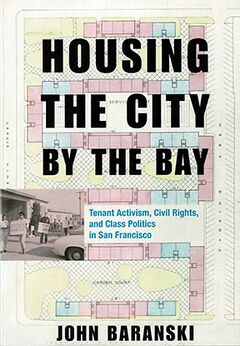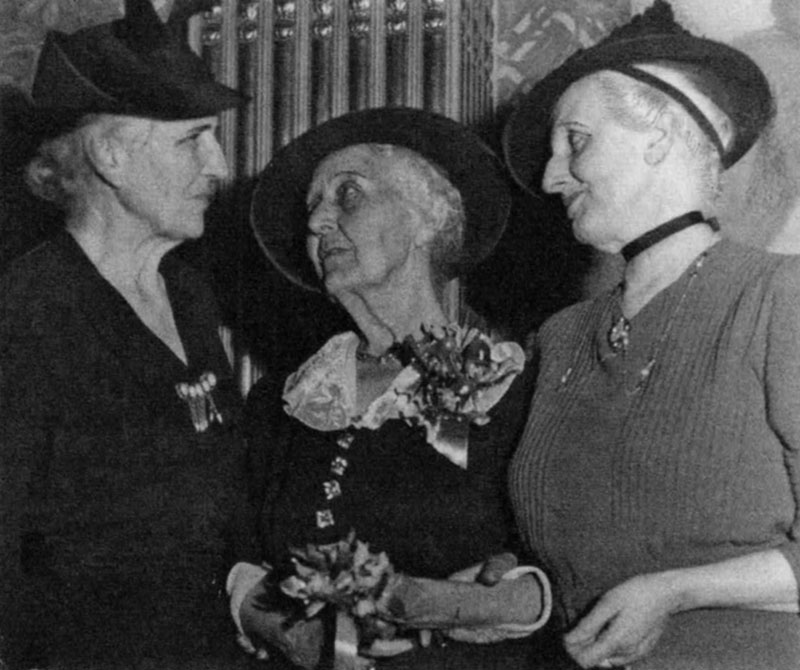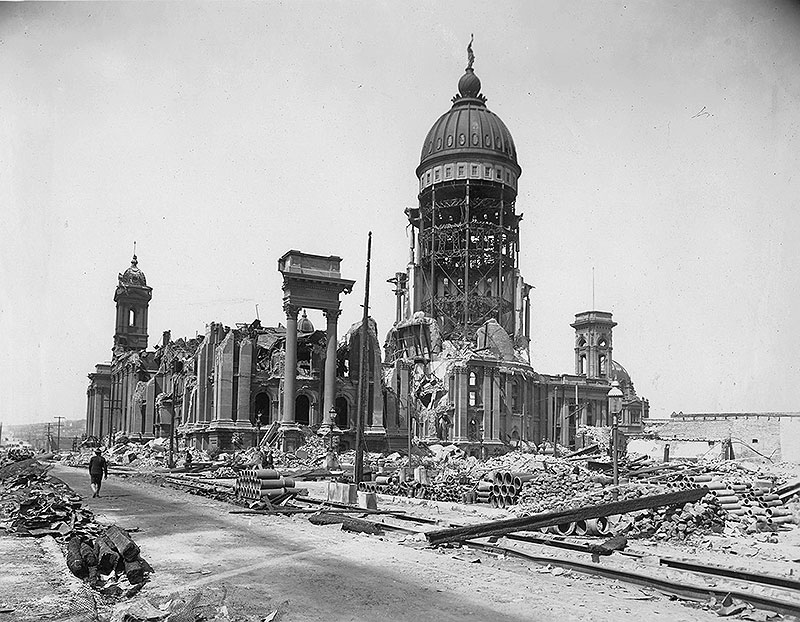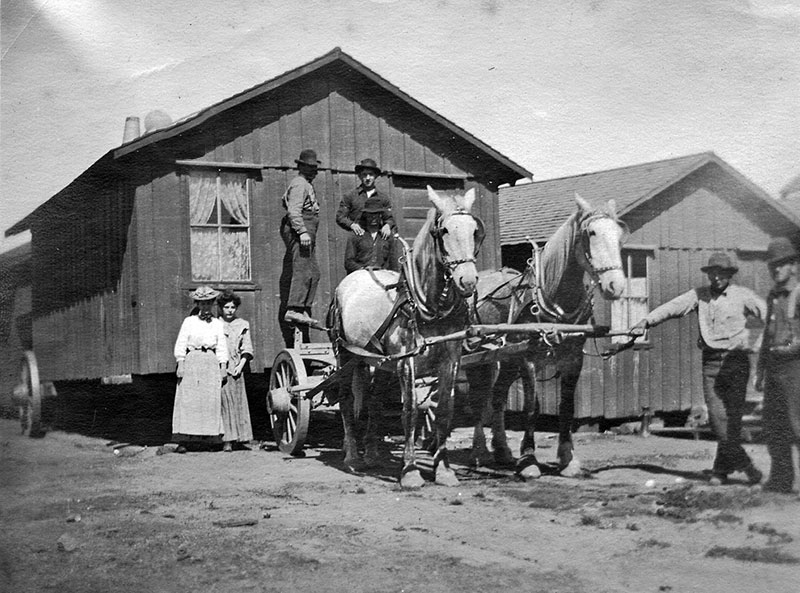Post-1906 Quake Housing Reform
Historical Essay
by John Baranski
This excerpt originally appeared in Progressive Era Housing Reform in Chapter One of Housing the City by the Bay: Tenant Activism, Civil Rights, and Class Politics in San Francisco (see below for copyright and book information)
Housing reformers Elizabeth Ashe (left), Alice Griffith (center), and Mrs. Harry M. Sherman (née Lucia Kittle) (right), at the Social Service Clubs in 1940.
Photo: San Francisco History Center, SF Public Library
The [1906] quake intensified an existing housing problem. Indeed, once the immediate task of providing food, health care, and emergency shelter passed, a small group of social reformers in the city returned to housing and urban reform. Like many throughout the Atlantic World, they asked how should the state be used to make government more responsive and democratic to ordinary people, to develop land and resources in rational ways, and to improve the standard of living and health of workers? Those questions, generally called the “labor question,” guided reformers and radicals who conducted social research, advocated public policies to protect workers and tenants, and built organizations such as political parties and labor unions. In San Francisco, a group of reformers, made up mostly of middle- and upper-income white women, worked to improve housing and planning and in the process acquired a degree of expertise based on their political experiences and their utilization of social scientific research.
In the aftermath of the quake, these housing reformers advocated for an expanded government role in housing and planning, including public housing, and aimed to pass new regulations and laws contributing to new housing reform institutions. However, their failure to inspire and work in cooperation with non- whites, with workers and their labor unions, and with tenants in a meaningful way limited their achievements in housing reforms. Property owners retained their power over housing and urban space. Still, the reform efforts in this period did lay important intellectual, political, and organizational groundwork for New Deal housing initiatives in the 1930s and contributed to the rise of the new liberalism amid the debates about the proper role of government in ensuring the economic rights of citizens. This chapter places the work of San Francisco’s reformers in the context of the international reform community and housing reforms of the 1920s, following developments in the housing reform movement into the first years of the Great Depression.
Remains of San Francisco's original City Hall after the 1906 earthquake and fire.
Photo: San Francisco History Center, SF Public Library
As news of the 1906 disaster spread around the world, individuals, relief organizations, and governments—local, state, and national—donated more than $10 million in cash and goods to assist San Francisco residents. Debates over how to use the do- nations for relief and housing illustrated a general reluctance among the city’s elites to help ordinary people and expand the economic rights of citizens. The American Red Cross sent in “professional charity men,” some from as far away as New York City, while San Francisco leaders and social workers formed the Finance Committee and the Finance Corporation. These two quasi-public organizations drew from the city’s business and political elites (male only), local social workers, and Red Cross staff. Social workers and Red Cross staff set up dozens of soup kitchens and gave modest cash grants to businessmen and “deserving” individuals. Administrators viewed their relief work as essential for humanitarian reasons and for stimulating the local economy, but the distribution of relief also challenged prevailing ideas about individual responsibility and the proper role of charity and government. Many San Francisco merchants thought that the distribution of subsidized and free goods hurt their businesses. Social workers, for their part, expressed concerns that not all recipients were deserving and that they might become dependent on assistance. When Katherine Felton, who was a leading social worker in San Francisco and California, worried aloud about a recipient’s “willingness to lean on public aid indefinitely,” she was stating a popular belief both inside and outside of San Francisco.(4) These ideas about individual responsibility and the role of private and public assistance influenced attempts to address the labor question.
After the quake, the pressing problem of housing led some reformers to advocate proposals outside of the speculative private housing market, and the discussion of these solutions reflected the uncomfortable but evolving relationship that such reformers had with relief and social programs. With the housing crisis increasing homelessness and residents’ flight from the city—among them construction workers needed for rebuilding—the Finance Committee and Finance Corporation took immediate measures, including arranging for construction of temporary tents in parks and vacant lots and providing grants and low-interest loans to homeowners for rebuilding. But clearly a more long-term solution was needed. Dr. Edward T. Devine, a New Yorker sent to San Francisco by the American Red Cross and a member of the Finance Committee, had the most ambitious proposal.(5)
Devine called for the establishment of a nonprofit public corporation with the power to build, sell, and rent permanent housing. The housing would be not just for the usual long-term dependents of city government—such as the aged, infirm, and invalid—but also for workers who did not earn enough money to rent or buy their own homes. He recommended using $3 to $4 million of the committee’s money for housing. His program was designed to put money into circulation, create jobs, and make housing for residents who might otherwise leave for want of shelter. Inherent in Devine’s program was the conviction that public agencies should provide model homes and communities. “The intelligent and efficient carrying out of the plans proposed,” he wrote, “will enable the community to set a standard of attractive, sanitary, safe, and yet comparatively inexpensive dwellings which will have a beneficial effect not only in the immediate future but for the coming generation.”(6) There was also the recognition that private landlords and developers would not provide enough safe, affordable housing. “Private enterprise,” his Red Cross report noted, was “not providing for this necessity.”(7)
Others agreed. Among San Francisco social reformers, Alice Griffith and Elizabeth Ashe fully supported Devine’s housing plan. Born into prominent San Francisco families, Griffith and Ashe in the 1880s volunteered for benevolent societies and were motivated by Social Gospel—a movement grounded in Christian values and addressing social problems through voluntary charitable work. By the turn of the twentieth century, they turned to social reform and settlement house efforts and combined their charitable work with a belief in government regulations and public programs to address the labor question. Their expertise was enhanced by trips to Europe, where they observed the latest progressive reforms and shared stories of their own community work.
Griffith became known as the Jane Addams of the West Coast. In 1902 she and Ashe co-founded the Telegraph Hill Neighborhood Association based on the Toynbee Hall and Hull House settlement house models. The Telegraph Hill settlement house, located in the largely immigrant North Beach district, became the first settlement house on the West Coast; it provided health care, adult education such as English classes, nursery school, daycare, and safe play areas for children. Telegraph Hill’s programs aimed to deter crime, bohemianism, and radicalism by promoting Americanism, but they also met some of the immediate needs of residents that were not provided by employers, government, and fraternal associations.(8)
The two women gained widespread respect for their dedication to fighting for the underdog. Knowing the benefits that municipal housing had brought to English cities, and moving from a faith in charity to government provision, Ashe and Griffith lobbied political and economic leaders for Devine’s housing plan. Significantly, the two did not attempt to mobilize tenants and workers behind these housing plans. Those they did lobby—San Francisco’s elites—by and large remained unconvinced that a public agency should build permanent low-income housing.
In the end, Devine’s plan for permanent projects was reduced to 5,610 temporary cottages and 19 two-story tenements for sale to the private sector. Demand for the cottages was “enormous,” according to the Red Cross, and many of the 17,000 residents housed in these buildings across the city regarded them as better than their pre-quake housing. By the summer of 1907, the tenants were given a choice: Either purchase and move the dwellings to individual lots or be forcibly removed by city park authorities.9 As thousands of families were forced back into the private housing market, the city’s first experiment with non-speculative, social housing came to an end.
Residents in front of a temporary cottage being moved to a lot in the city.
Photo: San Francisco History Center, SF Public Library

Excerpted from Housing the City by the Bay: Tenant Activism, Civil Rights, and Class Politics in San Francisco by John Baranski, published by Stanford University Press. Used by permission. © Copyright 2019 by John Baranski. All rights reserved.



